The best USB-C cables and adapters
Wirecutter tested 36 cables and 16 adapters.

By Sarah Witman
This post was done in partnership with Wirecutter. When readers choose to buy Wirecutter's independently chosen editorial picks, Wirecutter and Engadget may earn affiliate commission. Read the full guide to USB-C cables and adapters.
If you have a device with a USB-C port—like a MacBook or Android phone, or 2018 iPad Pro—you're going to need some cables. Unfortunately, when it comes to USB-C, even cables that look identical can perform very differently. Your MacBook's charging cable, for example, has the exact same connectors at each end as a top-speed Thunderbolt 3 cable, but it's different internally; it transfers data at a snail's pace, and it can't send a video signal. To make sure you get the right cable for your needs, we've tested 36 cables and 16 adapters to find the best ones for charging, data transfer, video, and more.
Name | Ports | USB-IF certified? | Length | Maximum charging rating | Charges USB-C laptops | Charges phones and tablets | Can carry video? | Maximum data rate |
Anker PowerLine II USB-C to USB-C 3.1 Gen 2 Cable | USB-C to USB-C | ✅ | 3 feet | 100 W | ✅ | ✅ | ✅ | USB 3.1 Gen 2 (10 Gbps) |
Anker PowerLine II USB-C to USB-C 2.0 Cable | USB-C to USB-C | ✅ | 6 feet | 60 W | ✅** | ✅ | - | USB 2.0 (480 Mbps) |
Cable Matters USB C to USB C Charging Cable | USB-C to USB-C | ✅ | 6.6 feet | 100 W | ✅ | ✅ | - | USB 2.0 (480 Mbps) |
Anker USB-C Thunderbolt Cable | Thunderbolt 3 (USB-C) to Thunderbolt 3 (USB-C) | - | 1.6 foot | 100 W | ✅ | ✅ | ✅ | Thunderbolt 3 (40 Gbps) |
Belkin USB-A to USB-C Charge Cable | USB-A to USB-C (cable) | ✅ | 6 feet | 60 W* | - | - | - | USB 2.0 (480 Mbps) |
AmazonBasics USB Type-C to USB-A Cable | USB-A to USB-C (cable) | ✅ | 3 feet | 60 W* | - | - | - | USB 3.1 Gen 2 (10 Gbps) |
Aukey USB-C to USB 3.0 Adapter | USB-A to USB-C (adapter) | - | nub | 60 W* | - | ✅ With additional cable | - | USB 3.1 Gen 1 / USB 3.0 (5 Gbps) |
AmazonBasics USB-C to USB 3.1 Gen 1 Adapter | USB-A to USB-C (adapter) | ✅ | 6 inches | 60 W** | - | ✅ With additional cable | - | USB 3.1 Gen 1 / USB 3.0 (5 Gbps) |
AmazonBasics USB Type-C to Micro-B 2.0 Cable | USB-C to Micro-USB (cable) | ✅ | 3 feet | 60 W* | - | ✅ (Micro-USB only) | - | USB 2.0 (480 Mbps) |
Aukey Type C To Micro USB Adapter | Micro-USB to USB-C (adapter) | - | nub | 15 W | - | ✅ With additional Micro-USB cable | - | USB 2.0 (480 Mbps) |
Anker PowerLine II USB-C to Lightning Cable (3 ft) | USB-C to Lightning | MFi certified | 3 feet | 18 W* | - | ✅ (iPhone and iPad only) | - | USB 2.0 (480 Mbps) |
*These cables and adapters were all rated by their manufacturers and confirmed in our testing for 60 W; however, most USB-A devices are limited to around 15 W (though some proprietary fast-charging protocols can exceed that).
USB-C–to–C cable for charging and fast data transfer
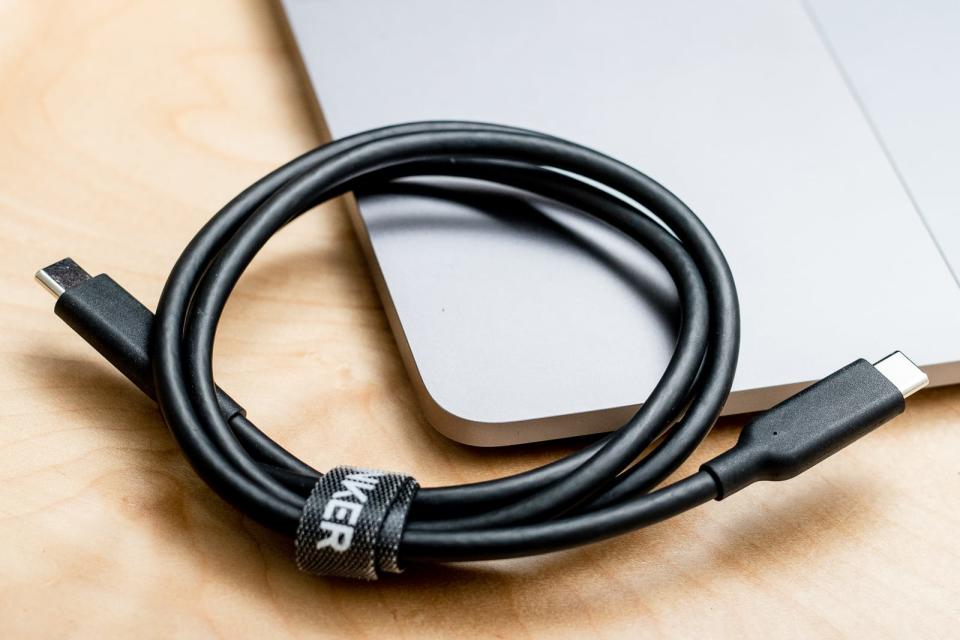
Why we love it: Anker's PowerLine II USB-C to USB-C 3.1 Gen 2 Cable can do it all. It meets USB-C specifications, like all cables we considered for this category (cables that violate these specs can possibly fry devices). As long as you're using the right charger, it supports up to 5-amp/100-watt charging, so it'll charge any USB-C device, even a 15-inch MacBook Pro, at maximum speeds. And with USB 3.1 Gen 2 speeds of up to 10 Gbps, it moves data as fast as a non-Thunderbolt USB-C port will currently allow—that's fast enough to transfer a full-length HD movie file in about 3 seconds. It feels sturdy and well-built, comes with a handy Velcro fastener, and has a lifetime warranty backed by a company we trust. Plus it's USB-IF certified—meaning that it meets a set of criteria designed by the USB Implementers Forum, a nonprofit company run by Apple, Intel, Microsoft, and other tech giants.
Flaws but not dealbreakers: It's more expensive than most USB-C cables, though most of the cheaper ones either can't transfer data at high speed, aren't rated for 100 W charging, or have a shorter warranty. It's also only 3 feet long, but since you'd likely be using this type of cable to connect a laptop to a storage drive, dock, or monitor—and not reaching from your nightstand to your bed, for example—we don't think it's a dealbreaker.
Key specs:
USB 3.1 Gen 2 data transfer rates (up to 10 Gbps)
5-amp and 100-watt charging
3 feet long
For charging phones, tablets, and laptops
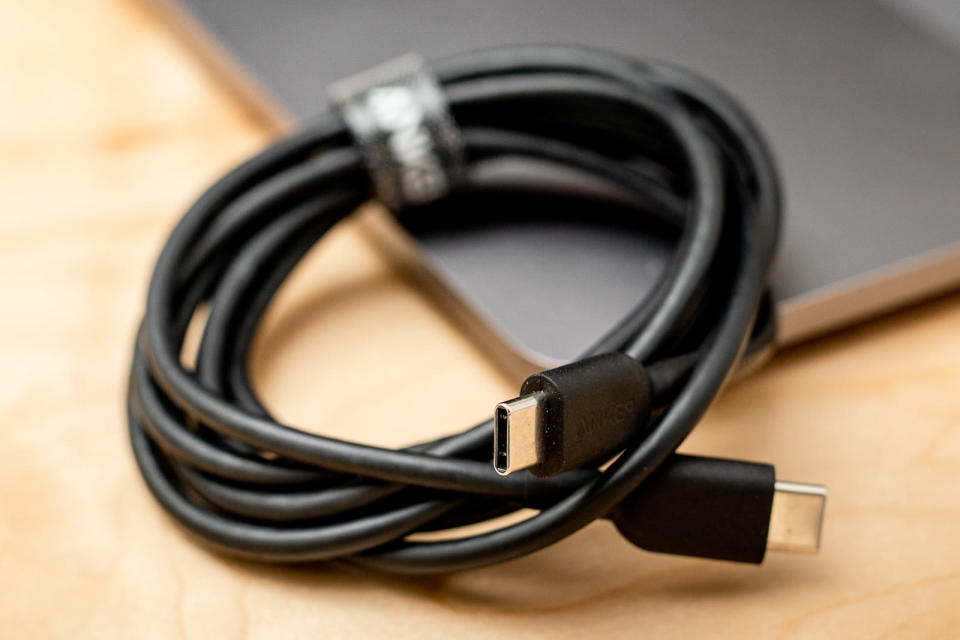
Why you might prefer it: The Anker PowerLine II USB-C to USB-C 2.0 Cable supports USB 2.0 data transfer speeds and carries power up to 60 W (we confirmed this in our testing), which is all you need for charging a USB-C phone, USB-C tablets (including the new iPad Pro), and most most laptops short of the 87 W 15-inch MacBook Pro. It's USB-IF certified, and it's backed by Anker's lifetime warranty. The 6-foot length is convenient for charging while sitting on a couch or in bed.
Flaws but not dealbreakers: As mentioned above, this cable's data transfer speeds are limited to USB 2.0. If you want a faster cable, you'll have to give up length, as top data speeds are only available on cables 3 feet long and shorter. But for charging your smartphone or laptop, an affordable cable with reliable charging capabilities is all you need, and this one fills the bill. It won't charge a large laptop, like the 15-inch MacBook Pro, at full speed though. Our next pick will, and it's often cheaper than the Anker, but it is a bit bulkier and has a shorter warranty, so most people who don't have a 15-inch Pro should get this one.
Key specs:
USB 2.0 data transfer rates (up to 480 Mbps)
3-amp and 60-watt charging
6 feet long (also available at 3 feet)
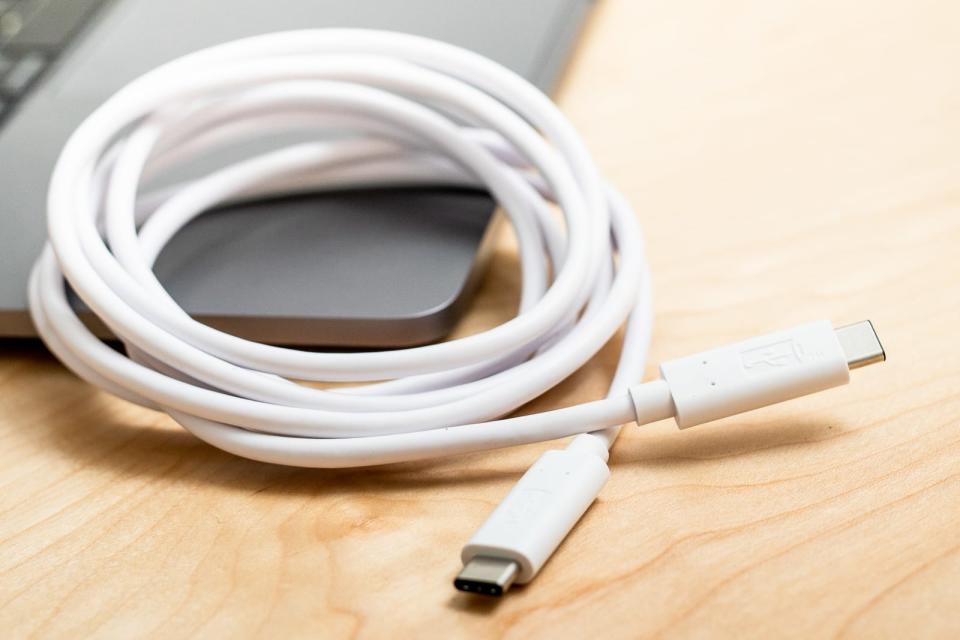
Why you might prefer it: The Cable Matters USB-C to USB-C Charging Cable is rated for 100 W charging, so it can recharge laptops like the 15-inch MacBook Pro, which comes with an 87 W charger, at full speed. At 6.6 feet, it's as long as any cable we tested in this category. It's USB-IF certified and has a one-year warranty backed by a company we trust. It performs just as well as Apple's 6.6-foot and 3.3-foot MacBook Pro charging cables (which aren't USB-IF certified) but costs half as much, and it's often cheaper than the 60 W Anker charging cable we recommend above.
Flaws but not dealbreakers: It only supports USB 2.0 data transfer speeds, it's a bit thicker and bulkier than the 60 W Anker cable, and its warranty is shorter than the Anker's.
Key specs:
USB 2.0 data transfer rates (up to 480 Mbps)
5-amp and 100-watt charging
6.6 feet long
Thunderbolt 3 cable
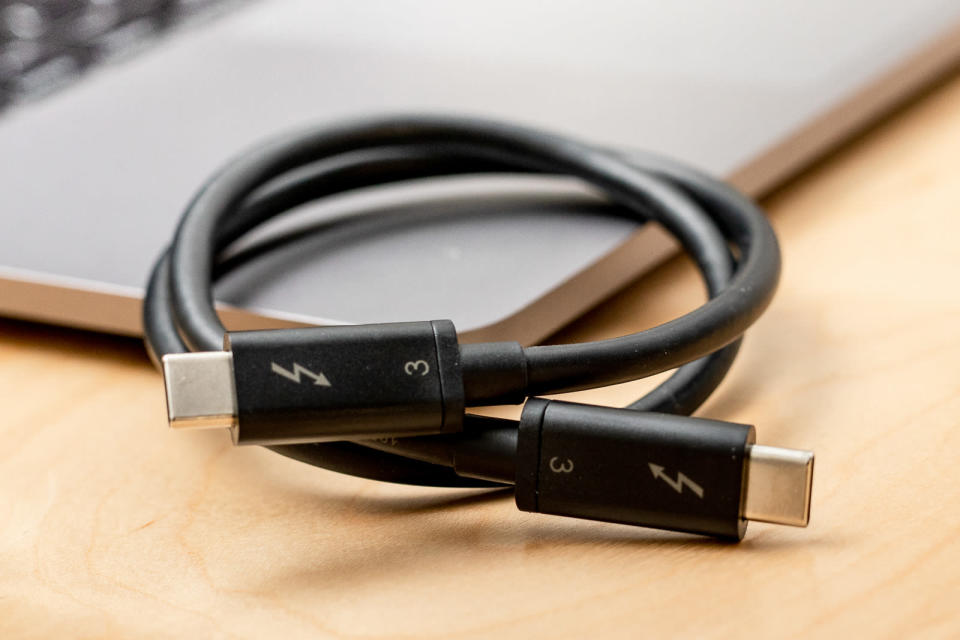
Why you might prefer it: The Anker USB-C Thunderbolt Cable is rated for 100 W charging, so it'll charge the 15-inch MacBook Pro or any high-powered laptop. It's Thunderbolt 3 capable, so although it looks like any other USB-C–to–USB-C cable (aside from the Thunderbolt logo on each end), it can transfer data up to 40 Gbps between supported devices. In our data transfer tests, we confirmed that the cable supports top speeds—on average, 2,172 Mbps read and 937 Mbps write speeds (or 17.4 and 7.5 gigabits, respectively) when connected to our test SSD on a full-speed Thunderbolt 3 port—which is as fast as anything else we tested. Plus, its 18-month warranty was the best we saw in this category. When used with non-Thunderbolt USB-C devices, it functions as a USB-C cable that supports 100 W charging and USB 3.1 Gen 2 data transfer speeds.
Flaws but not dealbreakers: The Anker USB-C Thunderbolt Cable is also shorter than we'd like—pretty much any cable less than 3 feet long is a thorn in our side—but in this case there's a practical reason. Sources like AppleInsider have reported that Thunderbolt 3 cables longer than 1.6 foot do not support top speeds. We tested Apple's 2.6-foot cable for comparison, and it performed no worse than any other Thunderbolt 3 cable in our tests. But just in case, we think you're better off getting this 1.6-foot cable.
Key specs:
Thunderbolt 3 data transfer rates (up to 40 Gbps)
5-amp and 100-watt charging
1.6 foot long
USB-A–to–USB-C cables and adapters
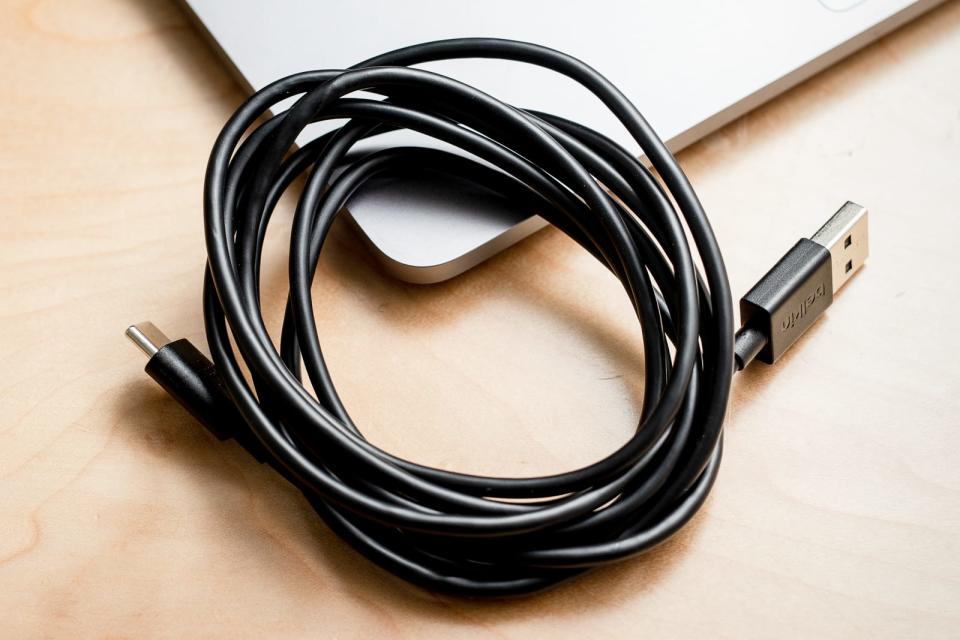
Why you might prefer it: This is the cable we'd use if we wanted to connect a USB-C device (like a newer Android phone or a USB-C power bank) to a USB-A charging port—whether it's on a laptop like the MacBook Air, a wall charger or wall outlet, a car charger, or a battery pack with legacy ports. Belkin's USB-A to USB-C Charge Cable is USB-IF certified, has a lifetime warranty, and feels solidly built. We like that it has a relatively thin cable (even at 6 feet long) that can be coiled up compactly. In our testing, it reached its full 60 W charging potential, although that's overengineering—standard USB-A charging tops out at 15 watts, and even proprietary charging standards like QuickCharge that work over USB-A don't exceed 20 W or so.
Flaws but not dealbreakers: Because the Belkin USB-A to USB-C Charge Cable only supports up to USB 2.0 data transfer speeds (480 Mbps), it's not the best option for moving lots of data between devices. However, we were unable to find a faster cable that's both USB-IF certified and 6 feet or longer. It's not impossible to make such a cable—according to USB-IF, a USB-C cable of any length can be certified as long as it passes all performance tests. But it might be bulkier than most people would want. A rep at Anker told us that the company's engineers have found that a 6-foot cable with full USB 3.1 Gen 2 speeds would just be too thick. Until we find a cable that supports USB 3.1 Gen 2 data transfer, is 6 feet or longer, and is USB-IF certified, we think the Belkin (which offers the latter two) is your best bet for charging.
Key specs:
USB 2.0 data transfer rates (up to 480 Mbps)
3-amp and 60-watt charging
6 feet long (also available at 5 feet long)
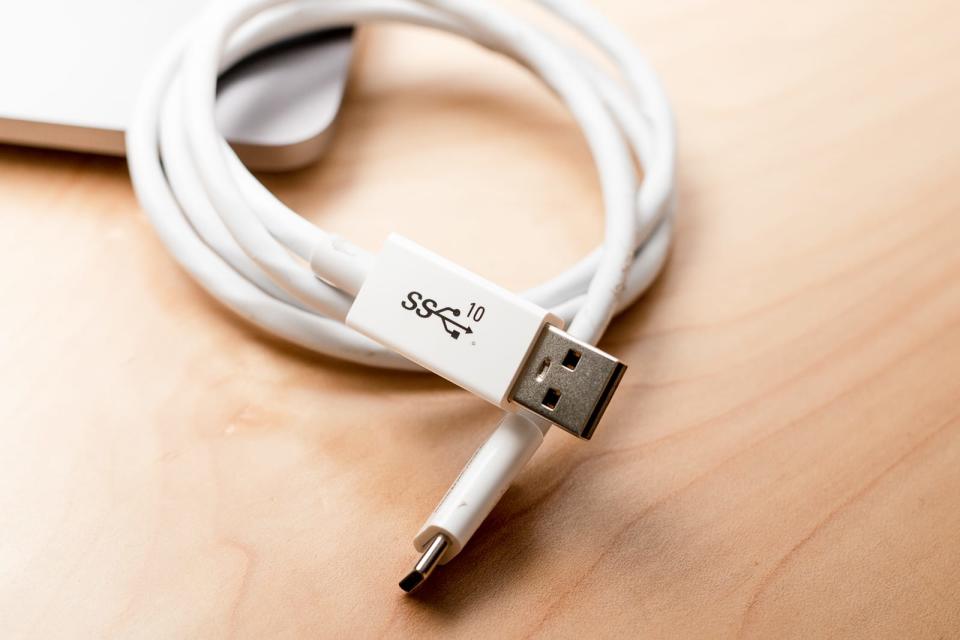
Why you might prefer it: The AmazonBasics USB Type-C to USB-A Cable is good for transferring data from a USB-C phone or storage device (such as a portable SSD) to a computer with a USB-A port because it supports up to 10 Gbps data transfer speeds. It's USB-IF certified, feels solidly built, and is backed by Amazon's one-year warranty.
Flaws but not dealbreakers: It would have been great to find a USB-A–to–USB-C cable that is USB-IF certified, is 6 feet or longer, and can transfer data at up to 10 Gbps (USB 3.1 Gen 2 speeds). We'll keep our eyes peeled for this elusive unicorn, but in the meantime the AmazonBasics is a fine option for fast data transfer between USB-A and USB-C devices. If you want a longer cable for charging, get our other pick in this category: the Belkin.
Key specs:
USB 3.1 Gen 2 data transfer rates (up to 10 Gbps)
3-amp and 60-watt charging (though most USB-A ports are limited to 18 W max)
3 feet long
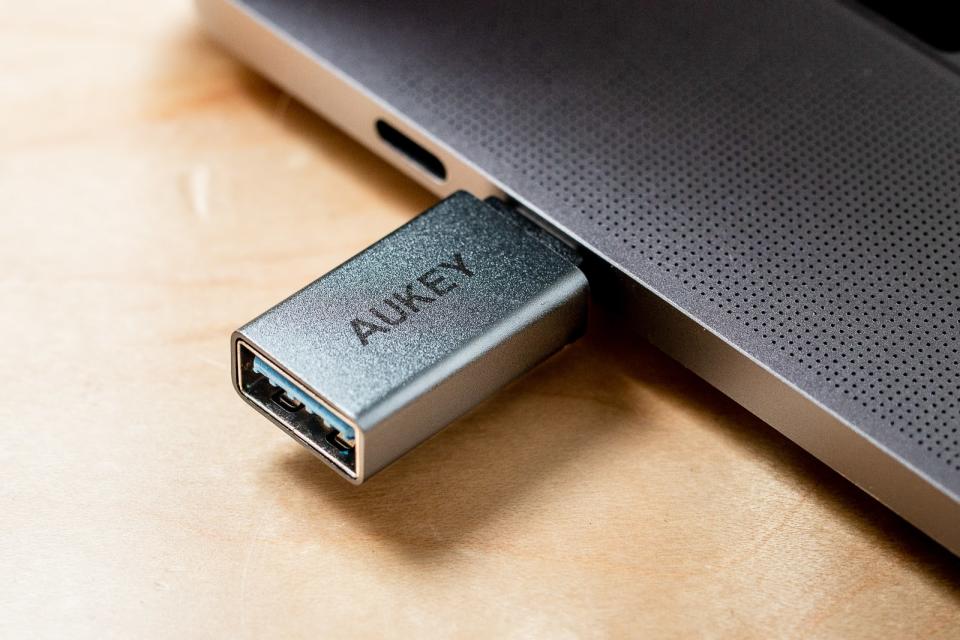
Why you might prefer it: The Aukey USB-C to USB 3.0 Adapter is a simple (and cheap) way to connect an existing USB-A cable into a USB-C port. This is great if you've bought a laptop devoid of USB-A ports, like a MacBook Pro, and don't feel like immediately replacing every cable and flash drive you own. After testing a handful of these teeny-tiny adapters, we're confident that Aukey's is the best. It has a 24-month warranty, and its size and shape make it easy to grip for plugging and unplugging.
Flaws but not dealbreakers: It's not USB-IF certified, but none of the ones we tested are. Otherwise it performed as well as we could have hoped.
Key specs:
USB 3.0 data transfer rates (up to 5 Gbps)
3-amp and 60-watt charging
0.3 inch thick
black, white, silver, space gray color options

Why you might prefer it: If you prefer a short cable over a nub adapter, go with the AmazonBasics USB-C to USB 3.1 Gen 1 Adapter. The advantage of a cable over a nub is that it moves the connected USB-A cable or flash drive away from the computer a bit—about 6 inches in this case. That extra length and flexibility can make it easier to use certain accessories—especially those with fat plugs. This adapter is USB-IF certified, it performed well in our testing, it supports USB 3.1 Gen 1 (which is another way of saying USB 3.0) data transfer, plus it's the least expensive model we tested.
Flaws but not dealbreakers: AmazonBasics's adapter had the shortest warranty (one year) of any we tested. But we've had good experiences with the company's customer service otherwise.
Key specs:
USB 3.0 data transfer rates (up to 5 Gbps)
6.3 inches long
Micro-USB–to–USB-C cable
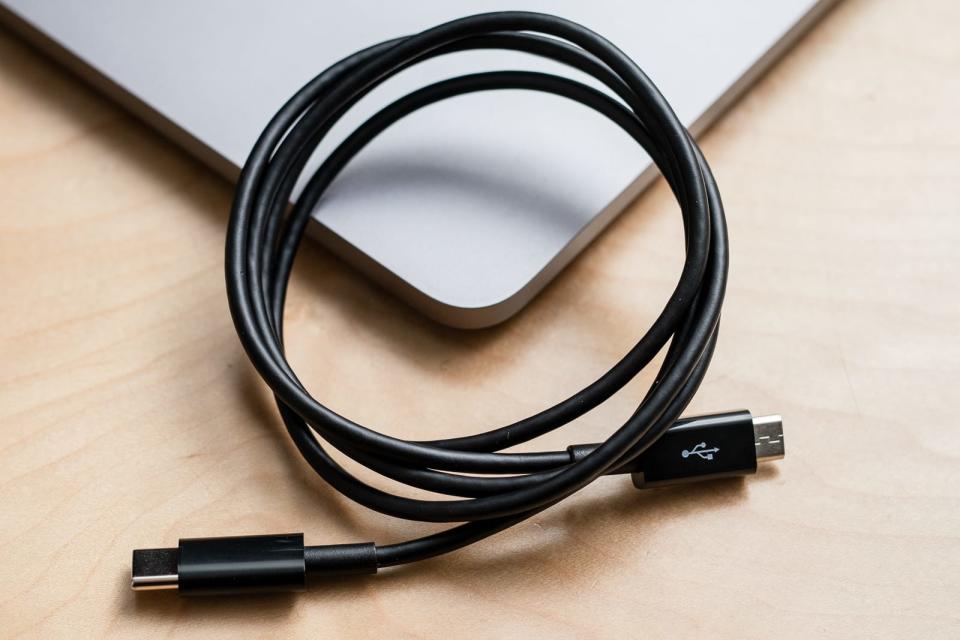
Why you might prefer it: The AmazonBasics USB Type-C to Micro-B 2.0 Cable is a functional length (3 feet) for something that more often than not will be used for charging a USB power bank, older Android phone, wireless mouse or keyboard, or a pair of wireless headphones from a computer. It's available in 6-inch and 6-foot lengths as well, though we didn't test those. It reached full charging and USB 2.0 data transfer speeds in our testing and has a nicely built, slim design. It's USB-IF certified and backed by Amazon's one-year warranty, and it's about half the price of comparable cables.
Flaws but not dealbreakers: This isn't the prettiest cable we've seen.
Key specs:
USB 2.0 data transfer rates (up to 480 Mbps)
Micro-USB–to–USB-C adapter
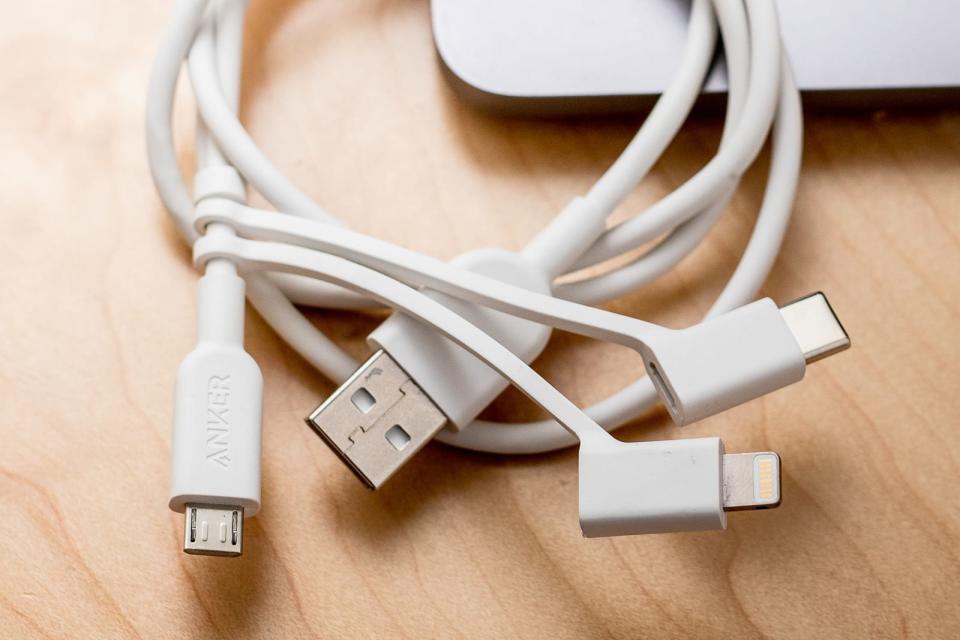
Why you might prefer it: Aukey's Type C To Micro USB Adapters are not much bigger than a fingernail but let you charge your USB-C devices using the Micro-USB cables you already have around. Because they're a bit chunkier than others we tested, they feel better to plug and unplug. The adapters performed just a hair better than the next-best adapter (Anker's version), and the 24-month warranty was the best of any we considered.
Flaws but not dealbreakers: We would have liked this adapter to have a USB-IF certification, but no company we know of has bothered to certify this kind of accessory.
Key specs:
USB 2.0 data transfer rates (up to 480 Mbps)
⅖ inch thick
USB-C–to–Lightning cable
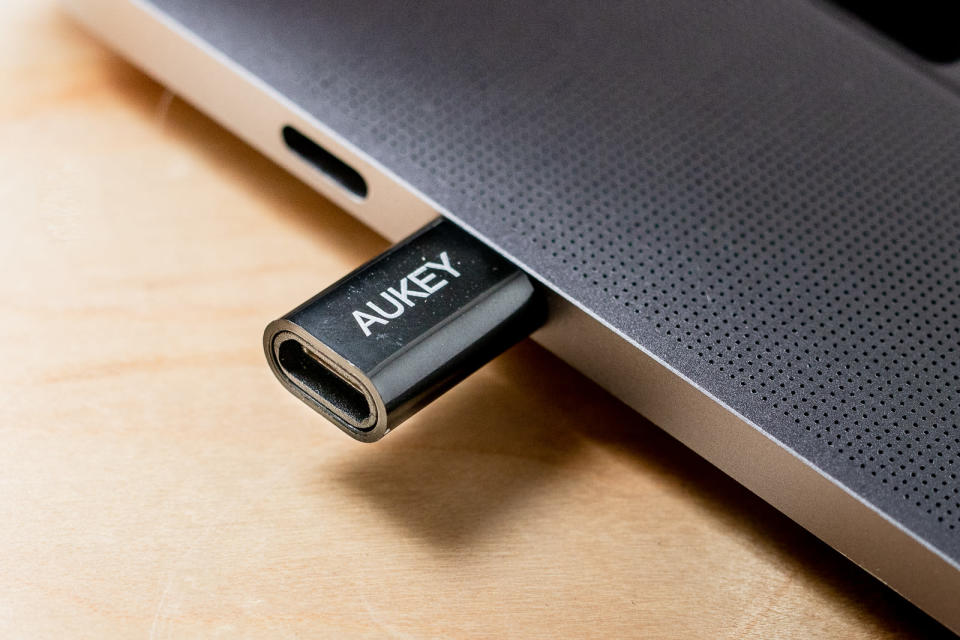
Why you might prefer it: USB-C–to–Lightning cables allow you to charge iPhones (8/8 Plus or later) and most iPad Pros (excluding the newest model, which charges via USB-C) at much faster speeds than the stock charger when paired with a high-speed USB-C charger. Although our equipment doesn't yet let us test the internal capabilities of any USB-C–to–Lightning cables, we did a head-to-head comparison of two MFi-certified options—the Anker PowerLine II and Apple's version—and we prefer the Anker. Its rubber sheath is thicker than the one encasing the Apple cable, yet flexible and compact enough to easily stow in a pocket or pouch. Unlike Apple's cables, the plastic housings that join the metal connectors to the Anker cable seem sturdy and robust—built to withstand bending or fraying, even with frequent use. And its MFi-certified status means that it meets Apple's standards to ensure optimal performance with its devices—from iPhones to Magic Trackpads—in terms of charging and data-transfer capabilities. Although you can buy unlicensed third-party options, we chose not to consider them. Since they might not be fully compatible with Apple devices, you risk the cable fitting incorrectly, overheating, and damaging the cable, device, or both; now that there are MFi-licensed third-party cables available, there's even less reason to consider a cable that isn't.
Flaws but not dealbreakers: While the official Apple cable comes in 3.3- and 6.6-foot versions, Anker's 3- and 6-foot cables are a bit shorter.
Key specs:
USB 2.0 data transfer rates (up to 480 Mbps)
USB Power Delivery (USB-PD) fast charging
3 feet long (also comes in a 6-foot version)
Three-in-one (Micro-USB, USB-C, Lightning) cable
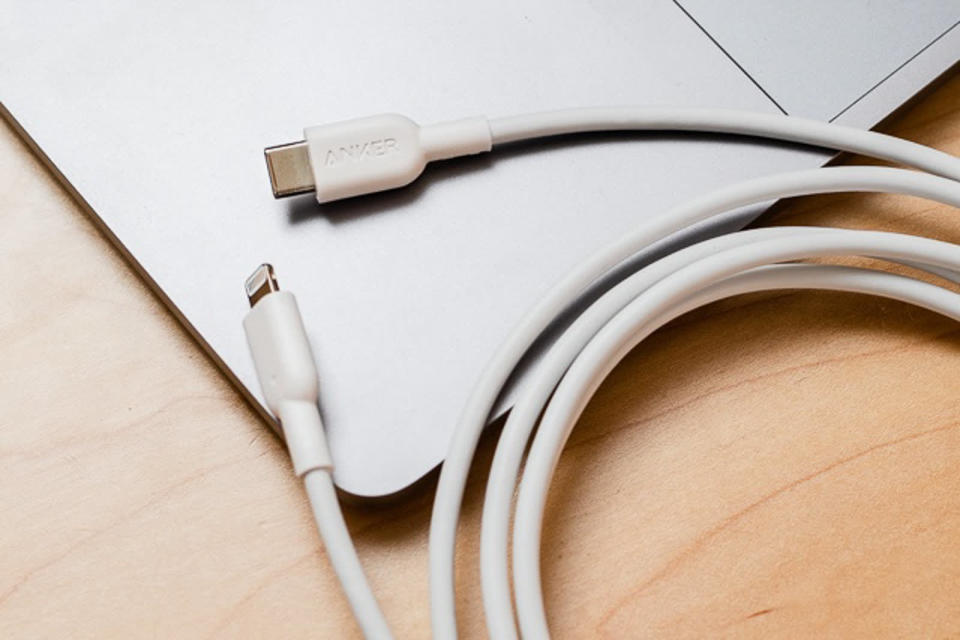
Why you might prefer it: A three-in-one cable is, essentially, a USB-A–to–Micro-USB cable with Lightning and USB-C adapters attached by short tethers. While we don't recommend using them on a daily basis because they're limited to slow data speeds and the adapters can be a pain, we do think they can be handy for travel, or as a backup you can throw in your desk drawer. Of the ones we tried, the Anker Power Line II 3-in-1 Cable was the clear winner. It's MFi-certified, it got top marks in our power draw and data transfer tests (like every three-in-one cable we tested, it only supports USB 2.0 data speeds), and it seems well made. It has a slim cable that's easy to coil up and stow in a bag, and its adapters were the easiest to plug and unplug—the other ones we tried were fussy and difficult to wrangle. It was the only model we tested that did not have some kind of continuity, signal integrity, or DC resistance error when we ran it through Total Phase's Advanced Cable Tester. And it's backed by Anker's lifetime warranty.
Flaws but not dealbreakers: In theory, the three-in-one cable is a convenient, compact alternative to carrying around three individual cables. But in practice we found all of them cumbersome to use—an inelegant solution to addressing different standards and legacy connectors. But if you regularly use all three specs (Micro-USB, USB-C, and Lightning) and hate carrying around three different cables, this is a decent option. We wish its rubber adapter tethers were easier to maneuver and built more sturdily—we fear that they'd break after repeated use—but none of the models we tested impressed us in this regard. This cable's slim, compact design and good overall performance make it the best of the worst.
Key specs:
USB 2.0 data transfer rates (up to 480 Mbps)
Up to 5 V and 3 A charging (15 W)
3 feet long
Notable competitors
USB-C–to–USB-C cables for charging phones, tablets, and laptops up to 60 W
AmazonBasics USB-C to USB-C 3.1 Gen 1 Cable
This cable worked fine in our testing, but had an F rating on Fakespot the last time we checked, and some reviewers say it stopped working after about a month and a half.
AmazonBasics USB-C to USB-C 2.0 Cable
This cable performed similarly to our pick (the Anker Powerline II USB-C to USB-C 2.0 Cable) in terms of power-draw and data transfer speeds, but its plastic housings feel flimsier and its warranty is shorter—one year compared with a lifetime.
Anker Powerline USB-C to USB-C 2.0 Cable (6 feet)
This used to be our pick in this category, but unlike our current pick, also an Anker, it's not USB-IF certified.
Belkin MIXIT DuraTek USB-C Cable
This cable performed about the same as our Anker pick in our power-draw and data transfer tests. It has a pretty good (five-year) warranty, and we really like the braided fabric encasing the cable. But we do not care for the ridges between the smooth and matte sections of the cable housings—they feel inelegant—and it costs more than double that of every other cable we tested.
Google USB-C to USB-C Cable (USB 2.0)
This is the standard-issue cable that ships with the Google Pixel 2. It's fine, but we didn't consider it for testing, since it costs so much more than other contenders.
USB-C–to–USB-C cables for charging MacBook Pro and other high-powered laptops
Apple USB-C Charge Cable (6.6 feet)
This was our former pick in this category, but it's not USB-IF certified. Plus, our current pick (from Cable Matters) costs a fraction of this one and is just as good.
Apple USB-C Charge Cable (3.3 feet)
This cable, launched in October 2018, is half the length and twice the price of our Cable Matters pick, and it's not USB-IF certified. While its slim design makes it more compact and portable than our pick, it feels notably underbuilt compared with the competition—it's as slim as Apple's standard Lightning cable and has less reinforcement at the cuff, and it seems as likely to break.
Moshi Integra USB-C Charge Cable and Moshi Integra USB-C Charge Cable with Smart LED
These cables performed just as well as the Cable Matters in our power-draw and data-transfer tests, and we like their luxe look and feel. But neither Moshi cable is USB-IF certified, and they are about double and triple the price, respectively, of the Cable Matters.
USB-C–to–USB-C cables with 100 W charging and USB 3.1 Gen 2 data transfer
Nekteck USB-C to USB-C 3.1 Gen 2 Cable (10Gbps/100W)
This cable earned full marks in all of our tests, and at 3.3 feet it's even longer than our pick, the Anker. However, we don't like the rough texture of its plastic housings—we find them to be a bit clunky in general—and its warranty (one year) doesn't stand up to Anker's lifetime warranty.
J5Create USB 3.1 Type-C to Type-C Coaxial Cable
This cable is slightly shorter than our pick (2.3 feet to Anker's 3-foot cable) and has only a one-year warranty, whereas the Anker has a lifetime warranty.
Thunderbolt 3 cables
Belkin 60W Thunderbolt 3 Cable and Belkin 100W Thunderbolt 3 Cable
These cables performed about as well as Anker's version in our tests, and they're both backed by two-year warranties—the Anker's is 18 months. Anker's cable is also more widely available, though, and we think the matte finish of its housings makes it look and feel more luxe than the Belkin models.
Apple Thunderbolt 3 (USB-C) Cable
This cable performed no worse than Anker's in our testing, but it has a shorter warranty (one year) and costs more. Plus, according to sources like AppleInsider, any Thunderbolt 3 cable longer than 1.6 foot (like this one, which is 2.6 feet) won't provide top speeds.
USB-A–to–USB-C cables
AmazonBasics USB-C to USB-A 2.0 Cable
This cable is similar to our Belkin pick in that it's a good (6-foot) length, it's USB-IF certified, it performed well in our power-draw tests, and it only gets up to USB 2.0 speeds. Unlike the Belkin, though, it has a short one-year warranty and somewhat flimsier housings.
Anker Powerline USB-C to USB 3.0 Cable (3 feet)
Our former pick in this section, this cable was ousted in our latest round of testing for not being USB-IF certified. Our new picks, the AmazonBasics and Belkin, both have this certification and performed as well or better than the Anker in our testing.
Anker Powerline USB-C to USB 3.0 Cable (6 feet)
This cable is a nice length (6 feet), it has a great look and feel, and it achieved full USB 3.1 Gen 2 data transfer speeds (10 Gbps) in our testing. But, in addition to not being USB-IF certified, the Total Phase Advanced Cable Tester reported DC resistance and signal-integrity errors in our testing.
Anker Powerline USB-C to USB 3.0 Cable (10 feet)
This 10-foot cable was the longest we tested this round. Unfortunately, it's not USB-IF certified, it only got up to about 5 Gbps in our testing (USB 3.0 data transfer speeds), and it had DC–resistance and signal-integrity errors when we ran it through the Total Phase Advanced Cable Tester. Also, due in part to its impressive length, it's extremely bulky.
Anker PowerLine+ USB-C to USB 3.0 Cable
This USB-C–to–USB-A cable performed well in our tests, and its braided cable makes it a bit sturdier than our picks. But it's not USB-IF certified and, as electrical engineer Lee Johnson demonstrated for our guide to Lightning cables, we don't think most people need such a rugged design.
This cable performed well in our power-draw tests, and it achieved full USB 3.1 Gen 2 data transfer speeds. But it isn't USB-IF certified, it's only 3.3 feet long, and the Total Phase Advanced Cable Tester reported a signal-integrity error in our testing.
Belkin 3.1 USB-A to USB-C Cable
This cable is similar to our Belkin pick in this category, but it's not USB-IF certified and tends to cost about twice or three times as much.
The build quality of this cable is really nice: It is exceptionally thin, has a strain-relief collar to help prevent breakage over time, and has a built-in plastic clip keeps the cable coiled when it's not in use. But it's not USB-IF certified, it gets the slowest possible (USB 2.0) data transfer speeds, and it's only 3.2 feet long—we couldn't find a cable that meets all three criteria, but our AmazonBasics and Belkin picks both excel at two of the three.
Monoprice Essentials USB-C to USB-A 3.1 Gen 2 Cable
This cable performed well in our tests, it's USB-IF certified, it has the improved data-transfer speeds of USB 3.1 Gen 2, it has a lifetime warranty, and it costs a fraction of the price of some of the other USB 3.1 Gen 2 cables we tested. However, it doesn't have a particularly rugged or streamlined design, and it's only available to buy on Monoprice's own website, which charges shipping fees. If those drawbacks don't bother you, though, it's a good alternative to our AmazonBasics pick.
Moshi Integra USB-C to USB-A Charge Cable
This cable had decent charging abilities, it's a good (5-foot) length, and it has a nice-looking braided fabric encasing it. However, it's only capable of USB 2.0 data transfer speeds, and it's not USB-IF certified. It's also about double the cost of our picks.
Startech 2.0 USB-A to USB-C Cable
This cable is probably the most similar to our Belkin pick of those we tested: It's 6 feet long, USB-IF certified, earned good marks in our power-draw tests, and only gets up to USB 2.0 speeds. But even though it costs about the same as the Belkin, it's not as nice to look at and feels cheaper.
USB-A–to–USB-C adapters (nub style)
Kanex's USB Type C-to-USB Adapter, iXCC's USB-C to USB 3.0 Converter, and Nonda's USB-C to USB 3.0 Adapter all performed well but are too fat and clunky, making it basically impossible to fit two plugs into side-by-side ports. Rankie's USB-C to USB-A 3.0 Adapter felt cheaply built compared with the others we tested.
USB-A–to–USB-C adapters (short cable style)
Among Anker's USB-C to USB 3.1 Adapter, Aukey's USB C to USB 3.0 Cable Adapter, iXCC's USB Type C to USB 3.0 Type A Adapter, and Moshi's USB-C to USB-A Adapter, none are USB-IF certified.
Monoprice Essentials USB Type C to USB-A Extension Cable
This adapter was one of the top contenders in this category. Like our pick, it supports USB 3.0 data transfer and it's USB-IF certified. But its housings are a little bulkier than our pick's, and it's only available to buy on Monoprice's website, which charges for shipping and is less convenient for most people.
Micro-USB–to–USB-C cables
Belkin 2.0 USB-C to Micro-USB Charge Cable
This cable performed just as well as our pick (the AmazonBasics) in our testing, and like our pick it's USB-IF certified. At 6 feet long, it's also twice the length of our pick, and it has a two-year warranty, which is double that of our pick. But it had a DC–resistance error when we ran it through the Total Phase Advanced Cable Tester, it's about twice the price of the AmazonBasics, and it's thicker and bulkier.
Micro-USB–to–USB-C adapters
Anker USB-C to Micro-USB Adapter
This adapter matched our pick, the Aukey, in price and performance, but we think its slimmer design makes it harder to use and easier to lose. It also has an 18-month warranty, whereas the Aukey's is 24 months.
JSAUX USB-C to Micro-USB Convert Connector
This adapter performed abysmally in our power-draw tests—2.3 watts compared with 7.4 watts by the Anker and Aukey adapters. We also think the little built-in plastic loops and silver chains (designed to attach the adapters to a keychain) are impractical and tacky.
Three-in-one (Micro-USB, USB-C, Lightning) cables
Monoprice USB-A to Micro-USB, USB-C, Lightning Cable
This cable was a close second to our pick, the Anker. Like our pick, it is MFi-certified and 3 feet long, and it has a lifetime warranty. It has a nice, slim design, making it compact and portable—which is key, since we really only recommend three-in-one cables as a travel or backup option. We also felt that its adapters were the easiest to plug in and unplug of any we tried. Its downfall was a series of errors (both in signal integrity and continuity) in our Total Phase tests, whereas our pick had none.
Nomad USB-A to Micro-USB, USB-C, Lightning Cable
Like our pick, this cable is MFi–certified and passed all of our data transfer and power-draw tests. At 5 feet long, it's 2 feet longer than our pick, yet it's still fairly compact. Its braided fabric sheath and rubber cable keeper are nice touches. But this cable's plastic housings were the worst of any we tried—plugging and unplugging them feels like doing battle with an unyielding opponent. Plus, the Total Phase Advanced Cable Tester reported a DC–resistance error.
How we picked and tested
Before beginning our initial round of testing in 2015, we consulted with Nathan K., a volunteer with the Top Contributor Program at Google. He's an independent tester who has worked with Benson Leung, a famed (in these circles) Google engineer who first brought to light potential issues with USB-C accessories that didn't conform to USB-C specifications.
In our latest round of testing, we used an Advanced Cable Tester from Total Phase (a fancy $1,500 piece of equipment) to scrutinize the wiring and signal integrity, DC resistance, and compliance with USB-C specifications of every cable we tested. We also used it to double-check our other data transfer speed and power-draw measurements.

To test the data transfer capabilities of the USB-C–to–USB-C cables for phones, tablets, and laptops up to 60 W, we plugged one end of each cable into a Samsung T3 Portable SSD (not our current portable SSD pick, but still one of the fastest drives available with a USB-C connection) and the other end into a 2016 13-inch MacBook Pro with four Thunderbolt 3 ports. We then ran a free system-performance app called AJA System Test Lite on the laptop to measure read/write speeds in MB/s. To test power draw, we used the 13-inch laptop, a Satechi ammeter, and a first-generation Google Pixel, and we noted the maximum power-draw readings on the ammeter as well as on the laptop's System Report.
To test the data transfer capabilities of USB-C–to–USB-C cables with USB 3.1 Gen 2 data transfer and 100 W charging, we plugged one end of each cable into a Samsung T3 and the other end into a 2017 15-inch MacBook Pro and ran AJA System Test Lite. To test power draw, we used the 15-inch laptop, the ammeter, and Apple's 87W USB-C Power Adapter, and noted the maximum power-draw readings on the ammeter as well as the laptop's System Report.
To test the data transfer capabilities of Thunderbolt 3 cables, we plugged one end of each cable into a LaCie Bolt 3 (a desktop SSD with Thunderbolt 3 ports) and the other end into the 13-inch MacBook, and ran AJA System Test Lite. To test power draw, we used the 13-inch laptop, the ammeter, and Apple's 61W USB-C Power Adapter, and noted the maximum power-draw readings on the ammeter as well as the laptop's System Report. To test USB-C–to–USB-C cables for the MacBook Pro and other high-powered laptops, we used the same methods but with the Samsung T3 instead of the LaCie Bolt 3.
To test the data-transfer capabilities of the USB-C–to–USB-A cables, we plugged the USB-C end into the 13-inch laptop and the USB-A end into an Aukey USB-A–to–USB-C adapter. We then plugged the adapter into the Samsung T3 and ran AJA System Test Lite. To test power draw, we used the ammeter, the Pixel, and our favorite travel-size multiport USB wall charger (the Anker PowerPort 2) and noted the maximum power-draw readings on the ammeter.
To test USB-C–to–USB-A adapters, we plugged the USB-C end into the 13-inch laptop and the USB-A end into a SanDisk Extreme CZ80 16GB USB 3.0 Flash Drive and ran AJA System Test Lite. To test USB-C–to–Micro-USB adapters, we plugged the Micro-USB end into our favorite USB-A–to–Micro-USB cable (Anker's PowerLine Micro USB) and the Anker Powerport 2. We then plugged the USB-C end into the ammeter and the Pixel and noted the maximum power-draw readings on the ammeter. To test three-in-one cables, we ran all three adapters (Lightning, Micro-USB, and USB-C) through the equivalent data transfer and power-draw tests for each connector type.
We describe how we've historically tested Lightning cables in our full guide. But at the time of testing, Apple's official cable had to be our USB-C–to–Lightning pick by default, since Apple didn't license the Lightning connector for use with third-party USB-C accessories, and we chose not to consider unlicensed cables. However, at the CES 2019 trade show Belkin announced the first licensed third-party cable, so we'll test that soon. While other cables are available—and some even claim to be faster than Apple's cable—we think buying an unlicensed version that could potentially fit incorrectly, overheat, or damage your device (or the cable itself) is not worth the risk.
On every test we ran, we made each measurement three times per cable, unplugging the cable between measurements, and calculated the average. After collecting data on all the contenders, we considered other factors—USB-IF and MFi certifications, length, price, availability, brand reputation, warranty and customer support, ease of use, packability, and aesthetics—to make our final decisions.
What to look forward to
We are in the process of testing more MFi-certified USB-C–to–Lightning cables against our pick—including Anker's PowerLine+ II, a version of our current pick encased in fabric; a 3-foot cable from RAVPower; a 4-foot cable from Kanex; a 4-foot cable from Scosche; two 4-foot Belkin cables; two 3-foot cables (one encased in plastic, and one in fabric) from Griffin; a 3-foot ESR cable; and a 3-foot UGreen cable—and we will update this guide with our results as soon as we can. We'll continue to test other MFi-certified USB-C–to–Lightning cables as they become available.
We've been asked about a recommendation for a USB-C extender cable (like this or this), but we don't have one because they aren't permitted under USB-C specifications. For a cable like this to work properly, it (and your other cables or connectors) would need to have heavy-gauge power wires, which would make the cable thick, inflexible, and expensive. However, we'll keep an eye on the category and update this guide if anything changes.
We also don't recommend any adapters that purport to add a MagSafe–like capability to existing USB-C charging cables. Like many MagSafe proponents, we were disappointed when Apple started phasing out this feature a few years ago. But we don't think the smattering of adapters that have since come out—from companies such as Griffin and Leonis—have succeeded at extending the golden age of MagSafe. The ones we've seen are inelegant, leaving a little (or not so little) nub sticking out of the side of a laptop when the cable is disconnected. We're waiting on a more reliable, sleeker version of these adapters to surface before testing.
If you didn't find what you were looking for here, check out the rest of our guides to the best USB-C accessories.
This guide may have been updated by Wirecutter. To see the current recommendation, please go here.
When readers choose to buy Wirecutter's independently chosen editorial picks, Wirecutter and Engadget may earn affiliate commissions.
